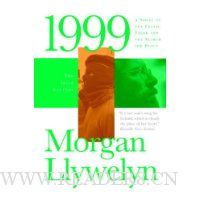基本信息·出版社:Forge Books ·页码:400 页 ·出版日期:2008年02月 ·ISBN:0312878494 ·International Standard Book Number:0312878494 ·条形码 ...
| 商家名称 |
信用等级 |
购买信息 |
订购本书 |
|
|
 |
1999: A Novel of the CelticTiger and the Search for Peace |
 |
|
 |
1999: A Novel of the CelticTiger and the Search for Peace |
 |

基本信息·出版社:Forge Books
·页码:400 页
·出版日期:2008年02月
·ISBN:0312878494
·International Standard Book Number:0312878494
·条形码:9780312878498
·EAN:9780312878498
·版本:1st
·装帧:精装
·正文语种:英语
·丛书名:Irish Century
内容简介 The Irish Century concludes in this climactic novel; Llywelyn’s masterpiece is complete
The Irish Century series is the story of the Irish people’s epic struggle for independence through the tumultuous course of the twentieth century. Morgan Llywelyn’s magisterial multi-novel chronicle of that story began with 1916, which was followed by 1921, 1949, and 1972. It now concludes with 1999: A Novel of the Celtic Tiger and the Search for Peace. 1999 brings the story from 1972 to the disarmament talks and beginnings of reconciliation among the Irish at the end of the twentieth century.
Barry Halloran, strong, clever, and passionately patriotic, who was the central character of 1972, remains central. Now a crippled photojournalist, he marries his beloved Barbara Kavanaugh, and steps back from the armed struggle. Through his work he documents the historic events that take us from the horrific aftermath of Bloody Sunday through the decades of The Troubles to the present. This is a noble conclusion to an historical mega-novel that will be read for years.
作者简介 MORGAN LLYWELYN lives near Dublin, Ireland
媒体推荐 "Her characters spring instantly to life and the reader remains captivated from first page to last.”—Jean M. Auel on
Grania"Well-realized characters and a vivid history make for richly gratifying reading.”—
Publishers Weekly on
1942 "The lucid narrative and the compelling subject matter will enthrall both Irish history buffs and fans of sweeping historical fiction.” --
Booklist on
1921 “In Llywelyn’s skilled hands the lives of the fictional and real-life characters mesh as miscalculations, misjudgments, and betrayal lead inexorably to the firing squad. . . . 1916 is an involving and enriching experience.” —The Edmonton Journal on 1916
“A masterpiece is how best I can describe this latest novel from the pen of Morgan Llywelyn. . . . It is a difficult undertaking to get the facts right yet have a rip-roaring yarn. I think Morgan Llywelyn has succeeded in this and the book would stand scrutiny by critics and historians alike. A marvelous achievement.” —
Republican News (Dublin) on
1916 专业书评 From Publishers WeeklyIn Llywelyn's fifth and final installment in the Irish Century series, she offers a fastidious take on The Troubles, weaving facts and historical figures with the fictitious lives of a former IRA soldier, his American-born wife and his resolute republican mother. Photojournalist Barry Halloran, formerly an IRA Volunteer, races from the aftermath of Bloody Sunday to Dublin, where he seeks the guidance of his training officer, Seamus McCoy. Concerned that the sickly Seamus wants to return to active service, Barry spontaneously proposes to his mercurial lover, Barbara, in order to detain Seamus as his best man for his wedding. After the wedding, Barbara turns into something of a shrew and Barry's career begins to take off—providing a convenient device to document the escalating conflict. Not even Seamus's imprisonment or the crippling of Barry's mother by a car bomb deters him from faithfully capturing The Troubles on film. Though Llywelyn is meticulous in cataloguing the wartime atrocities committed by both sides, the narrative lacks a driving force and loses steam in covering the myriad skirmishes and failed peace talks. Readers familiar with the previous volumes will enjoy this the most; the uninitiated may have trouble.
(Feb.) Copyright © Reed Business Information, a division of Reed Elsevier Inc. All rights reserved.
文摘 Chapter 1
Like candles blown out by a celestial wind, the last stars vanished.
The beam of headlamps swung wildly as the Austin Healey skidded on a patch of black ice. Barry Halloran turned into the skid and kept his foot on the accelerator. The green car fishtailed, teetered on the brink of a ditch, recovered and raced on.
Barry’s anger was unstoppable.
He hardly saw the road. Other images clouded his vision like a double exposure. Unarmed civilians being shot down in the street. An injured man shot in the back at point-blank range as he lay writhing on the pavement. An old woman battered to the ground with the butt of a rifle. British soldiers sniggering while the still-bleeding bodies of their victims were tossed into trucks like sides of beef.
On the screen of Barry’s mind the cinematic horror ran over and over again.
His knuckles were white on the steering wheel.
He had taken advantage of the better roads in Northern Ireland by driving south from Derry through Tyrone and Fermanagh. Avoiding the manned border crossing west of Enniskillen, he had entered the Republic of Ireland by a neglected byway, then angled southward again across Leitrim and Roscommon. Even when he reached County Galway very few lights were visible from the road. Much of the region was all but deserted. In the west of Ireland unemployment was endemic. Thousands of young men and women had “taken the boat” to England in search of jobs.
Signposts were notoriously unreliable. With nothing better to do, the local youngsters who remained behind often turned road signs to point in the wrong direction. The unwary driver could go miles out of his way before discovering his mistake.
Finbar Lewis Halloran needed no signposts to County Clare. The map was imprinted on the marrow of his bones.
By the time he turned into the country lan
……




